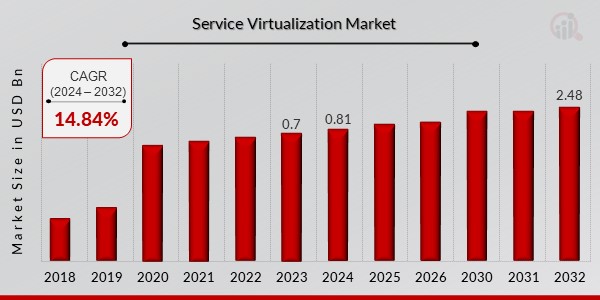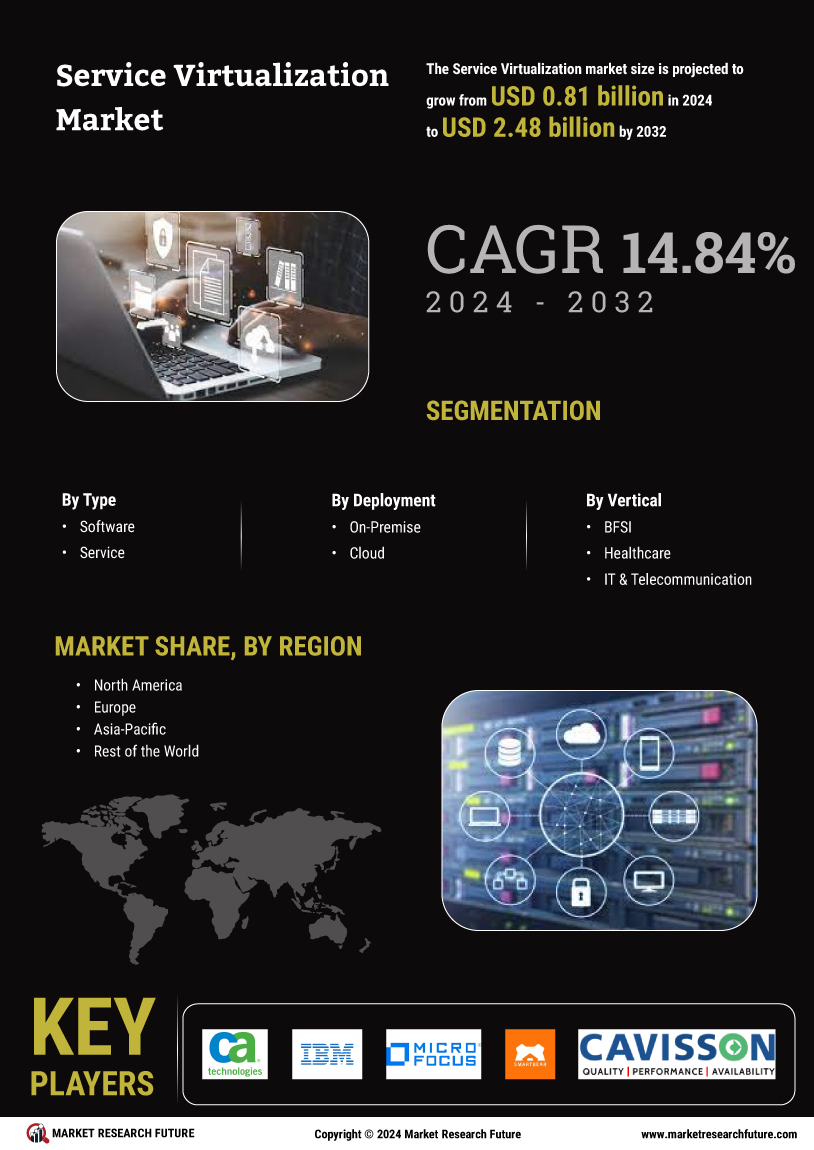Service Virtualization Market Overview
The Service Virtualization market size is projected to grow from USD 0.81 billion in 2024 to USD 2.48 billion by 2032, exhibiting a compound annual growth rate (CAGR) of 14.84% during the forecast period (2024 - 2032). Additionally, the market size for Service Virtualization was valued at USD 0.7 billion in 2023.
Increased development of smart cities, digitization of businesses in every corner, and growing demand for digital data integration solutions are the key market drivers incorporating market growth.
Figure1: Service Virtualization Market, 2018 - 2032 (USD Billion)

Source: Secondary Research, Primary Research, MRFR Database, and Analyst Review
Service Virtualization Market Trends
The growing adoption of Agile and DevOps methodologies is driving the market growth
The rising adoption of Agile and DevOps methodologies drives market CAGR for service virtualization. Agile and DevOps emphasize iterative development, continuous integration, and rapid deployment of software applications. These methodologies require extensive testing to ensure the quality and reliability of software products. However, testing in Agile and DevOps environments can be challenging due to dependencies on external systems that may need to be more readily available and easily configurable. Service virtualization addresses this challenge by enabling the creation of virtual test environments that replicate the behavior of dependent systems. It allows developers and testers to simulate the interactions and responses of these systems, eliminating the need for expensive and time-consuming manual testing. By adopting service virtualization, organizations can accelerate their development and testing cycles, improve testing accuracy, and reduce infrastructure and resource requirements costs.
Another trend shaping the service virtualization market is the increasing complexity of software ecosystems. Modern applications use related services, APIs, and third-party components. Testing these complex software ecosystems can be challenging due to the difficulty in managing and coordinating the dependent systems' behavior. Service virtualization offers a solution to this challenge by allowing organizations to model and simulate the behavior of these interconnected systems. It enables developers and testers to create virtual replicas of services, APIs, and components, eliminating the need for real, physical environments during testing. This ability to simulate the behavior of the entire software ecosystem in a controlled environment helps organizations identify and solve issues early in the development cycle, reducing time-to-market and improving overall software quality.
The selection of cloud computing has been on the rise across industries, and service virtualization is no exception. Cloud-based service virtualization solutions offer numerous benefits over traditional on-premises deployments. They provide scalability, flexibility, and cost-efficiency, enabling organizations to provision and manage virtual test environments per their requirements dynamically. Cloud-based service virtualization solutions also encourage collaboration among globally distributed development and testing teams. With cloud-based platforms, developers and testers can access virtual test environments from anywhere in the world, reducing the barriers posed by physical infrastructure and geographical limitations. It facilitates faster feedback cycles, enhances team productivity, and enables seamless integration with other cloud-based development and testing tools.
The global service virtualization market is witnessing significant growth due to the increasing adoption of Agile and DevOps methodologies, the growing complexity of software ecosystems, and the widespread adoption of cloud-based solutions. Organizations recognize service virtualization's value in improving development and testing processes, reducing costs, and enhancing software quality. As businesses strive for faster time-to-market and greater agility, service virtualization will remain a crucial technology for efficient software development and testing in the future, driving the Service Virtualization market revenue.
Service Virtualization Market Segment Insights
Service Virtualization Component Insights
The global Service Virtualization market segmentation, based on components, includes software and service. The service segment dominated the market. It provides consulting, implementation, and maintenance services, which assist organizations in effectively implementing and managing service virtualization solutions.
Service Virtualization Deployment Insights
The global Service Virtualization market segmentation, based on deployment, includes on-premise and cloud. The cloud category generated the most income. They offer flexibility and scalability, as organizations can access service virtualization resources on-demand from a cloud service provider. The cloud-based deployment segment is witnessing substantial growth due to its cost validness and ease of implementation.
Service Virtualization Vertical Insights
The global Service Virtualization market segmentation, based on vertical, includes BFSI, healthcare, IT & telecommunication, automotive, retail & E-commerce. The IT & telecommunication category generated the most income. It helps test complex applications and systems without needing all the underlying infrastructure.
Figure 2: Global Service Virtualization Market, by Vertical, 2022 & 2032 (USD Billion)

Source: Secondary Research, Primary Research, MRFR Database, and Analyst Review
Service Virtualization Regional Insights
By region, the study provides market insights into North America, Europe, Asia-Pacific, and the Rest of the World. The North American Service Virtualization market, will dominate due to the strong presence of major service virtualization vendors and large enterprises actively investing in advanced software testing solutions. The increasing adoption of Agile and DevOps methodologies in software development processes further drives the demand for service virtualization. Additionally, the region's well-established IT infrastructure and the presence of key industries such as BFSI, healthcare, and retail contribute to the market growth.
Further, the major countries studied in the market report are The US, Canada, German, France, the UK, Italy, Spain, China, Japan, India, Australia, South Korea, and Brazil.
Figure 3: GLOBAL SERVICE VIRTUALIZATION MARKET SHARE BY REGION 2022 (USD Billion)

Source: Secondary Research, Primary Research, MRFR Database, and Analyst Review
Europe's Service Virtualization market accounts for the second-largest market share due to the region's stringent regulatory environment, especially in industries like finance and healthcare, which necessitates rigorous testing and validation of software systems. Service virtualization helps organizations comply with these regulations by providing a controlled testing environment. Furthermore, the growing emphasis on digital transformation and the rising number of mobile and web applications drive the demand for efficient software testing solutions, including service virtualization. Further, the German Service Virtualization market held the largest market share, and the UK Service Virtualization market was the rapid-growing market in the European region.
The Asia-Pacific Service Virtualization Market is expected to grow fastest from 2023 to 2032. It is due to the increasing adoption of cloud computing, IoT, and mobile technologies creates a need for robust and agile software development and testing processes. Service virtualization enables organizations to accelerate the development cycle and reduce the time to market for their applications. Moreover, many IT service providers and outsourcing companies in countries like India fuel the demand for service virtualization solutions. Furthermore, China’s Service Virtualization market held the largest market share, and the Indian Service Virtualization market was the rapid-growing market in the Asia-Pacific region.
Service Virtualization Key Market Players & Competitive Insights
Leading market players are investing heavily in research and development to expand their product lines, which will help the Service Virtualization market grow even more. Market participants are also undertaking several strategic activities to expand their global footprint, with important market developments including new product launches, contractual agreements, mergers and acquisitions, higher investments, and collaboration with other organizations. The Service Virtualization industry must offer cost-effective items to expand and survive in a more competitive and rising market climate.
Manufacturing locally to minimize operational costs is one of the key business tactics manufacturers use in the global Service Virtualization industry to benefit clients and increase the market sector. The Service Virtualization industry has offered some of the most significant medical advantages in recent years. Major players in the Service Virtualization market, including CA Technologies (US), IBM (US), Micro Focus (Formerly HPE) (US), SmartBear Software (US), Cavisson Systems (US), Cognizant (US), Wipro (India), Sogeti (France), SQS (Germany), Maveric Systems (India), Prolifics (US), and others, are attempting to increase market demand by investing in research and development operations.
Adam Kolawa, Jon Flower, and Marc Goroff's Parasoft Corporation, founded in 1987, located in Monrovia, California, United States of America, is an independent software in automated software testing and application security. Its products include C/C++, Jtest, dotTest, Insure++, Selenic, Virtualise, DTP, and Continuous Testing Platform. It develops automated defect prevention technologies which support automated defect prevention methodology. In November 2020, Parasoft, a US-based organization, partnered with Lattix Inc. They combined the Lattix Architect solutions and Parasoft's test cycles software and tools. It enables them to develop faster virtual service software.
Corsa Security, founded in 2013, and located in Ottawa, ON, Canada, is a software-based networking company expert who is also a service and security virtualization expert to revolutionize network security. It helps large enterprises, service providers, security service providers, and large network owners scale network security. In October 2020, Corsa Security, a US-based organization, expanded its network security and virtualization services operations to automate the FWaaS (Firewall-as-a-Service). The new solution enables the Service Providers and Managed Security Service Providers to offer a virtualized FWaaS. It replaced the need for other physical firewalls.
Key Companies in the Service Virtualization market include
Service Virtualization Industry Developments
August 2019: Parasoft, a US-based organization, formed a partnership with a company named Auriga Inc. The basic aim of this venture was to provide Auriga's clients with time-efficient automated software testing tools. Parasoft is helping them to raise the level of their automatic services.
Service Virtualization Market Segmentation
Service Virtualization Type Outlook
Service Virtualization Deployment Outlook
Service Virtualization Vertical Outlook
-
BFSI
-
Healthcare
-
IT & Telecommunication
-
Automotive
-
Retail & E-Commerce
Service Virtualization Regional Outlook
-
North America
-
Europe
-
Germany
-
France
-
UK
-
Italy
-
Spain
-
Rest of Europe
-
Asia-Pacific
-
China
-
Japan
-
India
-
Australia
-
South Korea
-
Australia
| Attribute/Metric |
Details |
| Market Size 2023 |
USD 0.7 Billion |
| Market Size 2024 |
USD 0.81 Billion |
| Market Size 2032 |
USD 2.48 Billion |
| Compound Annual Growth Rate (CAGR) |
14.84% (2024-2032) |
| Base Year |
2023 |
| Market Forecast Period |
2024-2032 |
| Historical Data |
2018- 2022 |
| Market Forecast Units |
Value (USD Billion) |
| Report Coverage |
Revenue Forecast, Market Competitive Landscape, Growth Factors, and Trends |
| Segments Covered |
Component, Deployment, End-Use Industry, and Region |
| Geographies Covered |
North America, Europe, Asia Pacific, and the Rest of the World |
| Countries Covered |
The US, Canada, German, France, UK, Italy, Spain, China, Japan, India, Australia, South Korea, and Brazil |
| Key Companies Profiled |
CA Technologies (US), IBM (US), Micro Focus (Formerly HPE) (US), SmartBear Software (US), Cavisson Systems (US), Cognizant (US), Wipro (India), Sogeti (France), SQS (Germany), Maveric Systems (India), Prolifics (US). |
| Key Market Opportunities |
Growing adoption of service virtualization in various industries. |
| Key Market Dynamics |
Increase in the development of smart cities and digitalization of businesses in every corner worldwide. |
Service Virtualization Market Highlights:
Frequently Asked Questions (FAQ) :
The global Service Virtualization market size was valued at USD 0.7 Billion in 2023.
The global market is projected to grow at a CAGR of 14.84% during the forecast period, 2024-2032.
North America had the largest share of the global market.
The key players in the market are CA Technologies (US), IBM (US), Micro Focus (Formerly HPE) (US), SmartBear Software (US), Cavisson Systems (US), Cognizant (US), Wipro (India), Sogeti (France), SQS (Germany), Maveric Systems (India), Prolifics (US).
The service category dominated the market in 2022.
The cloud had the largest share of the global market.
IT & telecommunication had the largest share in the global market.


















